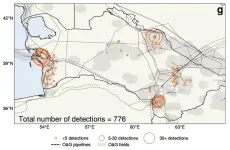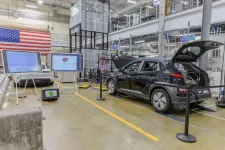(Press-News.org) Image
A protein engineering method using simple, cost-effective experiments and machine learning models can predict which proteins will be effective for a given purpose, according to a new study by University of Michigan researchers.
The method has far-reaching potential to assemble proteins and peptides for applications from industry tools to therapeutics. For instance, this technique can help speed up the development of stabilized peptides for treating diseases in ways that current medicines can't, including improving how exclusively antibodies bind to their targets in immunotherapy.
"The rules that govern how proteins work, from sequence to structure to function, are so complicated. Contributing to the interpretability of protein engineering efforts is particularly exciting," said Marshall Case, a doctoral graduate of chemical engineering at U-M and first author of the study.
Currently, most protein engineering experiments use complex, labor-intensive methods and expensive instruments to attain very precise data. The long process limits how much data can be acquired, and the complicated methods are challenging to learn and execute—a trade-off for precision.
"Our method has shown that for many applications, you can avoid these complicated methods," said Case, now a computational biologist at Manifold Biotechnologies.
The updated method starts by sorting cells into two groups, known as binary sorting, based on whether they express a desired trait—like binding to fluorescent molecules—or not. Then, the cells are sequenced to get the underlying DNA codes for the proteins of interest. Machine learning algorithms then reduce the noise in the sequencing data to identify the best possible protein.
"Rather than selecting the 'best book' from the library, it's like reading many books, then piecing together different pages from different stories to come up with the best book possible, even if it wasn't in your original library," said Greg Thurber, U-M associate professor of chemical engineering and corresponding author on the paper. "I was surprised to see the robustness of this technique using simple, binary sorting data."
Further enhancing its accessibility, the method uses linear machine learning models, which are easier to interpret compared to models with dozens of parameters.
"Because we can learn physical rules about how the proteins are actually working, we can use linear equations to model nonlinear protein behavior and make better drugs that way," Case said.
The research was conducted at the Advanced Genomics Core, Center for Structural Biology, Biological Mass Spectrometry Facility and Proteomics & Peptide Synthesis Core.
Additional University of Michigan co-authors: Matthew Smith of the Peter Tessier Lab and Jordan Vinh.
Study: Machine learning to predict continuous protein properties from binary cell sorting data and map unseen sequence space (DOI: 10.1073/pnas.2311726121)
END
A simple and robust experimental process for protein engineering
Easily interpretable technique can reduce the cost and increase the scale of protein optimization for applications in medicine, biofuels and more
2024-03-12
ELSE PRESS RELEASES FROM THIS DATE:
UTEP researchers to design movement-based training to support local health providers
2024-03-12
EL PASO, Texas (Mar. 12, 2024) – Burnout among health care workers is a well-documented problem that can exacerbate health disparities and limit access to care. Now, researchers at The University of Texas at El Paso are taking a creative approach in their search for a solution – a training program for providers that combines elements of art and science.
The project will examine the impact of a movement-based and somatics cross-training intervention on health care providers in the Paso del ...
Alaska dinosaur tracks reveal a lush, wet environment
2024-03-12
A large find of dinosaur tracks and fossilized plants and tree stumps in far northwestern Alaska provides new information about the climate and movement of animals near the time when they began traveling between the Asian and North American continents roughly 100 million years ago.
The findings by an international team of scientists led by paleontologist Anthony Fiorillo were published Jan. 30 in the journal Geosciences. Fiorillo researched in Alaska while at Southern Methodist University. He is now executive director of the New Mexico Museum of Natural History and Science.
University ...
Study: Best way to memorize stuff? It depends...
2024-03-12
Recent experiments by psychologists at Temple University and the University of Pittsburgh shed new light on how we learn and how we remember our real-world experiences.
The research, described in the March 12 online edition of Proceedings of the National Academy of Sciences (PNAS), suggests that varying what we study and spacing out our learning over time can both be helpful for memory — it just depends on what we’re trying to remember.
“Lots of prior research has shown that learning and ...
Exploring arctic plants and lichens: An important conservation baseline for Nunavut’s newest and largest territorial park
2024-03-12
Encompassing over 16 000 km2 of towering mountains, long fiords, lush valleys, and massive ice caps, Agguttinni Territorial Park is a protected area on northern Baffin Island, Nunavut, Canada. This park, and all of Nunavut, is Inuit Nunangat – Inuit homeland in Canada – and the park protects sites and biodiversity stewarded by Inuit since time immemorial.
Agguttinni means “where the prevailing wind occurs” in the Inuktitut local dialect. The park includes important bird areas, key habitats for polar bears and caribou, and numerous important Inuit cultural sites. It is very remote: no roads lead to it, and access ...
Multiple organ attack and immune dysregulation: Study reveals how the chikungunya virus leads to death
2024-03-12
The chikungunya virus, transmitted by Aedes aegypti and Aedes albopictus mosquitoes and responsible for more than 900 deaths in Brazil since it arrived around ten years ago, is capable of spreading through the blood, reaching multiple organs and crossing the blood-brain barrier, which protects the central nervous system. The mechanisms of action observed for the first time in fatal cases by a group of Brazilian, American and British researchers were reported in an article published on March 12 in the journal Cell Host & Microbe. The findings reinforce the need ...
Setting realistic expectations for recovery after robotic lung surgery
2024-03-12
Are surgeons giving patients unrealistic expectations about recovery after robotic lung surgery? That’s what CU Department of Surgery faculty member Robert Meguid, M.D., MPH, and surgery resident Adam Dyas, M.D., set out to discover after realizing the guidance they were offering patients might be based on outdated or anecdotal information.
“Traditionally, in surgery, we're taught to tell patients that they'll be back to normal from surgery within six weeks,” says Meguid, professor of cardiothoracic ...
UCF researchers lead $1.5 million project to improve efficiency of solar cells
2024-03-12
ORLANDO – A team of researchers from the University of Central Florida and the University of Delaware’s Institute of Energy Conversion has received a $1.5 million grant from the U.S. Department of Energy Solar Technologies Office to develop a novel metallization process that could improve the efficiency and lower the cost of solar cells, making solar energy more accessible to consumers.
The metallization process produces the metal contacts that are placed on the surface of silicon solar cells to ...
AI analysis of historical satellite images show USSR collapse in 1990s increased methane emissions, despite lower oil and gas production
2024-03-12
The collapse of the former Soviet Union in 1991 had social, political and economic effects worldwide. Among them was a suspected role in slowing human-generated methane emissions. Methane had been rising steadily in the atmosphere until about 1990. Atmospheric scientists theorized that economic collapse in the former USSR led to less oil and gas production, and thus a slowdown in the rise of global methane levels, which has since resumed.
But new University of Washington research uses early satellite records to dispute that assumption. The study, published March 12 in the ...
Charging up the commute
2024-03-12
A team of researchers at Oak Ridge National Laboratory demonstrated that a light-duty passenger electric vehicle can be wirelessly charged at 100-kW with 96% efficiency using polyphase electromagnetic coupling coils with rotating magnetic fields.
ORNL’s patented system transferred power to a Hyundai Kona EV across a five-inch airgap using electromagnetic fields, a process similar to the wireless charging of small consumer devices.
“We’ve achieved the highest power density in the world for a wireless charging system for this class of vehicle,” ORNL’s Omer Onar said. “Our ...
$5 million grant bets on computational biology, AI to change the future of cancer
2024-03-12
SAN FRANCISCO—A multidisciplinary research team at Gladstone Institutes, led by Senior Investigator Katie Pollard, PhD, has received $5 million in funding through a newly launched grant program designed to ignite a fresh wave of cancer discoveries using computational biology and artificial intelligence.
The new Transformative Computational Biology Grant Program from the Biswas Family Foundation, in partnership with the nonpartisan think tank Milken Institute, is providing a total of nearly $14 million to five research groups.
At Gladstone, the grant establishes ...
LAST 30 PRESS RELEASES:
COVID-19 leaves a lasting mark on the human brain
Scientists use ultrasound to soften and treat cancer tumors without damaging healthy tissue
Community swimming program for Black youth boosts skills, sense of belonging, study finds
Specific depressive symptoms in midlife linked to increased dementia risk
An ‘illuminating’ design sheds light on cholesterol
Who is more likely to get long COVID?
Study showcases resilience and rapid growth of “living rocks”
Naval Research Lab diver earns Office of Naval Research 2025 Sailor of the Year
New Mayo-led study establishes practical definition for rapidly progressive dementia
Fossil fuel industry’s “climate false solutions” reinforce its power and aggravate environmental injustice
Researchers reveal bias in a widely used measure of algorithm performance
Alcohol causes cancer. A study from IOCB Prague confirms damage to DNA and shows how cells defend against it
Hidden viruses in wastewater treatment may shape public health risks, study finds
Unlock the power of nature: how biomass can transform climate mitigation
Biochar reshapes hidden soil microbes that capture carbon dioxide in farmland
Reducing saturated fat intake shows mortality benefit, but only in high-risk individuals
Manta rays create mobile ecosystems, study finds
Study: Mixed results in using lipoic acid to treat progressive multiple sclerosis
Norbert Holtkamp appointed director of Fermi National Accelerator Laboratory
New agentic AI platform accelerates advanced optics design
Biologists discover neurons use physical signals — not electricity — to stabilize communication
Researchers discover that a hormone can access the brain by hitchhiking
University of Oklahoma researcher awarded funding to pursue AI-powered material design
Exploring how the visual system recovers following injury
Support for parents with infants at pediatric check-ups leads to better reading and math skills in elementary school
Kids’ behavioral health is a growing share of family health costs
Day & night: Cancer disrupts the brain’s natural rhythm
COVID-19 vaccination significantly reduces risk to pregnant women and baby
The role of vaccination in maternal and perinatal outcomes associated with COVID-19 in pregnancy
Mayo Clinic smartwatch system helps parents shorten and defuse children's severe tantrums early
[Press-News.org] A simple and robust experimental process for protein engineeringEasily interpretable technique can reduce the cost and increase the scale of protein optimization for applications in medicine, biofuels and more




